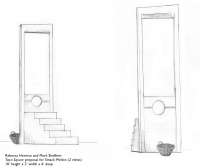Town Square is comprised of several sculptural elements: a tall, narrow, guillotine‐like structure in wood (without a blade); a series of steps leading up to the guillotine from the back; a basket on the floor in front of the guillotine; and two halves of a large wheel of cheese, one half in the basket and the other half on the top step. Visitors would first encounter the basket, and the tall sculpture; then, while walking around the installation, the steps. This “toothless” guillotine becomes a relic, as if in a museum of torture, referencing the ridiculous nature of previous, “backwards” systems of punishments, but bringing it into a contemporary context. The guillotine represents the idea of progress from primitive penal codes, as it was painless method of execution and a great improvement over previous rituals of public torture, such as being drawn and quartered. We ask the viewer to see the guillotine as a vernacular “social” sculpture, created by humans for use on humans. Town Square will also imply a performance or action just missed—a precarious fall, a dramatic drop, or a secretive ritual. The sculpture Town Square recalls the 1800s as a period of notable progress and upheaval in urban life, societal laws, and political structures, and considers how these changes manifest themselves through vernacular architecture and sculpture. In particular, the installation looks back to the guillotine in order to re‐consider this period of invention and relative improvements on forms of punishment.
Town Square is comprised of several sculptural elements: a tall, narrow, guillotine‐like structure in wood (without a blade); a series of steps leading up to the guillotine from the back; a basket on the floor in front of the guillotine; and two halves of a large wheel of cheese, one half in the basket and the other half on the top step. Visitors would first encounter the basket, and the tall sculpture; then, while walking around the installation, the steps. This “toothless” guillotine becomes a relic, as if in a museum of torture, referencing the ridiculous nature of previous, “backwards” systems of punishments, but bringing it into a contemporary context. The guillotine represents the idea of progress from primitive penal codes, as it was painless method of execution and a great improvement over previous rituals of public torture, such as being drawn and quartered. We ask the viewer to see the guillotine as a vernacular “social” sculpture, created by humans for use on humans. Town Square will also imply a performance or action just missed—a precarious fall, a dramatic drop, or a secretive ritual. The sculpture Town Square recalls the 1800s as a period of notable progress and upheaval in urban life, societal laws, and political structures, and considers how these changes manifest themselves through vernacular architecture and sculpture. In particular, the installation looks back to the guillotine in order to re‐consider this period of invention and relative improvements on forms of punishment.
